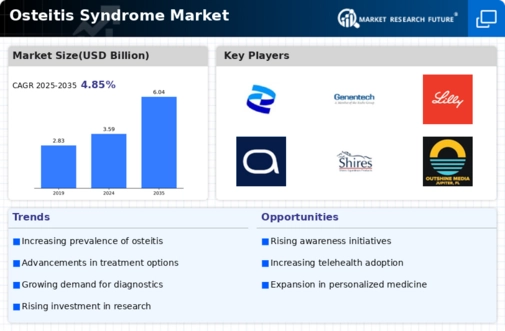Enhanced Diagnostic Techniques
Advancements in diagnostic techniques are significantly influencing the Osteitis Syndrome Market. Improved imaging technologies, such as MRI and CT scans, allow for earlier and more accurate detection of Osteitis Syndrome Market. This early diagnosis is crucial, as it enables timely intervention and management, potentially improving patient outcomes. As healthcare systems adopt these advanced diagnostic tools, the market for Osteitis Syndrome Market treatments is expected to expand. Furthermore, the integration of artificial intelligence in diagnostic processes may streamline patient assessment, leading to increased efficiency in treatment pathways. Thus, the evolution of diagnostic capabilities is likely to bolster the Osteitis Syndrome Market.
Increased Awareness of Bone Health
The heightened awareness of bone health is emerging as a significant driver for the Osteitis Syndrome Market. Public health campaigns and educational initiatives are informing individuals about the importance of maintaining bone integrity and the risks associated with conditions like Osteitis Syndrome Market. This increased awareness is likely to lead to more proactive health-seeking behaviors, resulting in earlier diagnosis and treatment. Furthermore, as individuals become more informed about their bone health, there may be a corresponding rise in demand for supplements and therapies aimed at preventing or managing Osteitis Syndrome Market. Consequently, the Osteitis Syndrome Market stands to benefit from this growing focus on bone health and wellness.
Rising Demand for Personalized Medicine
The shift towards personalized medicine is reshaping the Osteitis Syndrome Market. Patients are increasingly seeking tailored treatment options that consider their unique genetic and environmental factors. This trend is prompting healthcare providers to adopt more individualized approaches to managing Osteitis Syndrome Market. As a result, pharmaceutical companies are likely to invest in the development of targeted therapies that align with this demand. The market data indicates that personalized medicine is gaining traction, with a growing number of clinical trials focusing on specific patient populations. This evolution in treatment paradigms may enhance patient satisfaction and adherence, ultimately driving growth in the Osteitis Syndrome Market.
Increasing Incidence of Osteitis Syndrome
The rising incidence of Osteitis Syndrome Market appears to be a primary driver for the Osteitis Syndrome Market. Recent data indicates that the prevalence of this condition is on the rise, potentially due to factors such as an aging population and increased exposure to risk factors. As more individuals are diagnosed, the demand for effective treatment options and management strategies intensifies. This trend suggests that healthcare providers and pharmaceutical companies may need to allocate more resources towards research and development in this area. Consequently, the Osteitis Syndrome Market is likely to experience growth as stakeholders respond to the increasing need for innovative therapies and supportive care.
Growing Investment in Research and Development
Investment in research and development is a critical driver for the Osteitis Syndrome Market. Pharmaceutical companies and research institutions are increasingly focusing on understanding the underlying mechanisms of Osteitis Syndrome Market, which may lead to the discovery of novel therapeutic agents. Data suggests that funding for osteitis-related research has seen a notable increase, reflecting a commitment to addressing this condition. This influx of investment not only supports the development of new treatments but also fosters collaboration among researchers, healthcare providers, and industry stakeholders. As a result, the Osteitis Syndrome Market is poised for growth, driven by innovative solutions emerging from ongoing research efforts.

















Leave a Comment